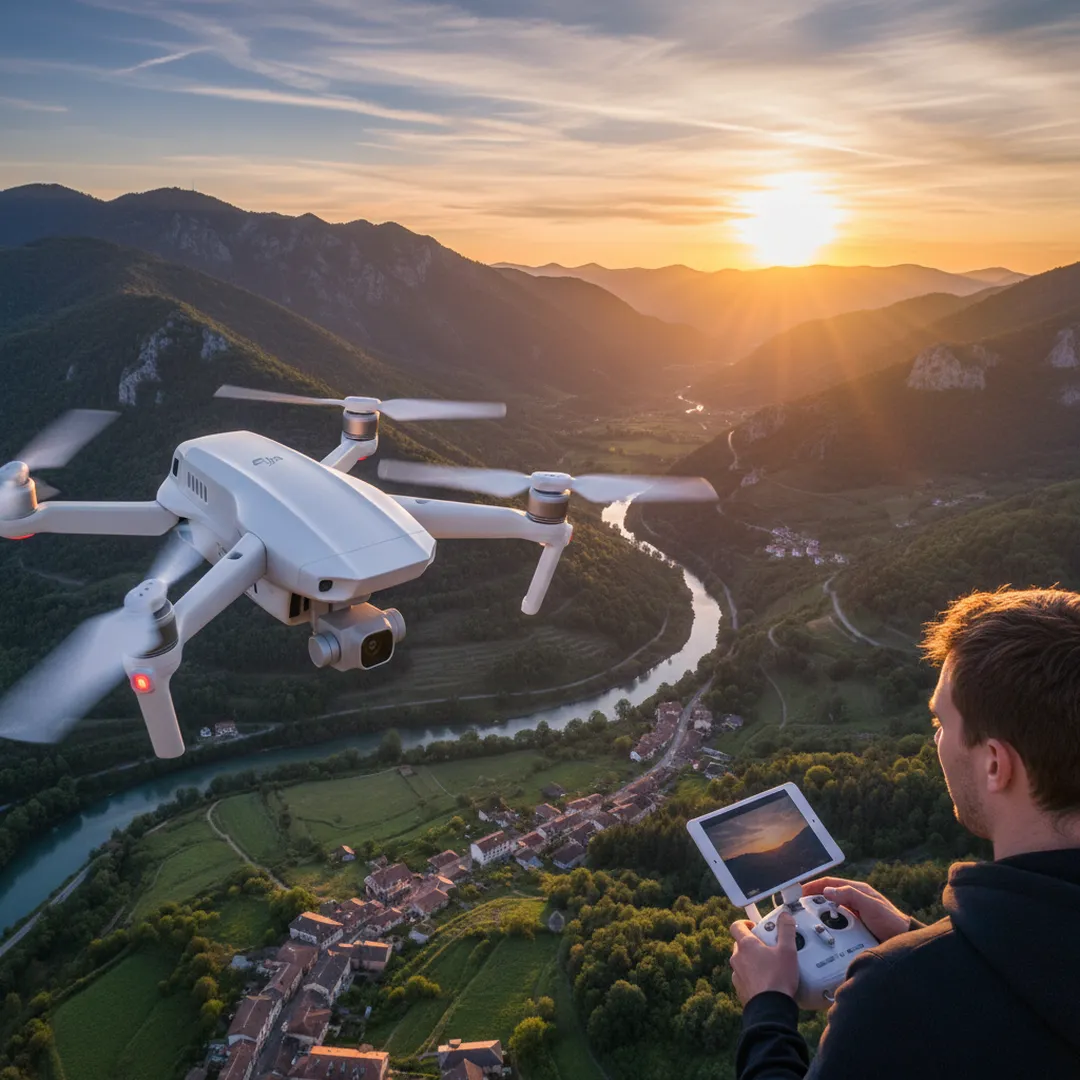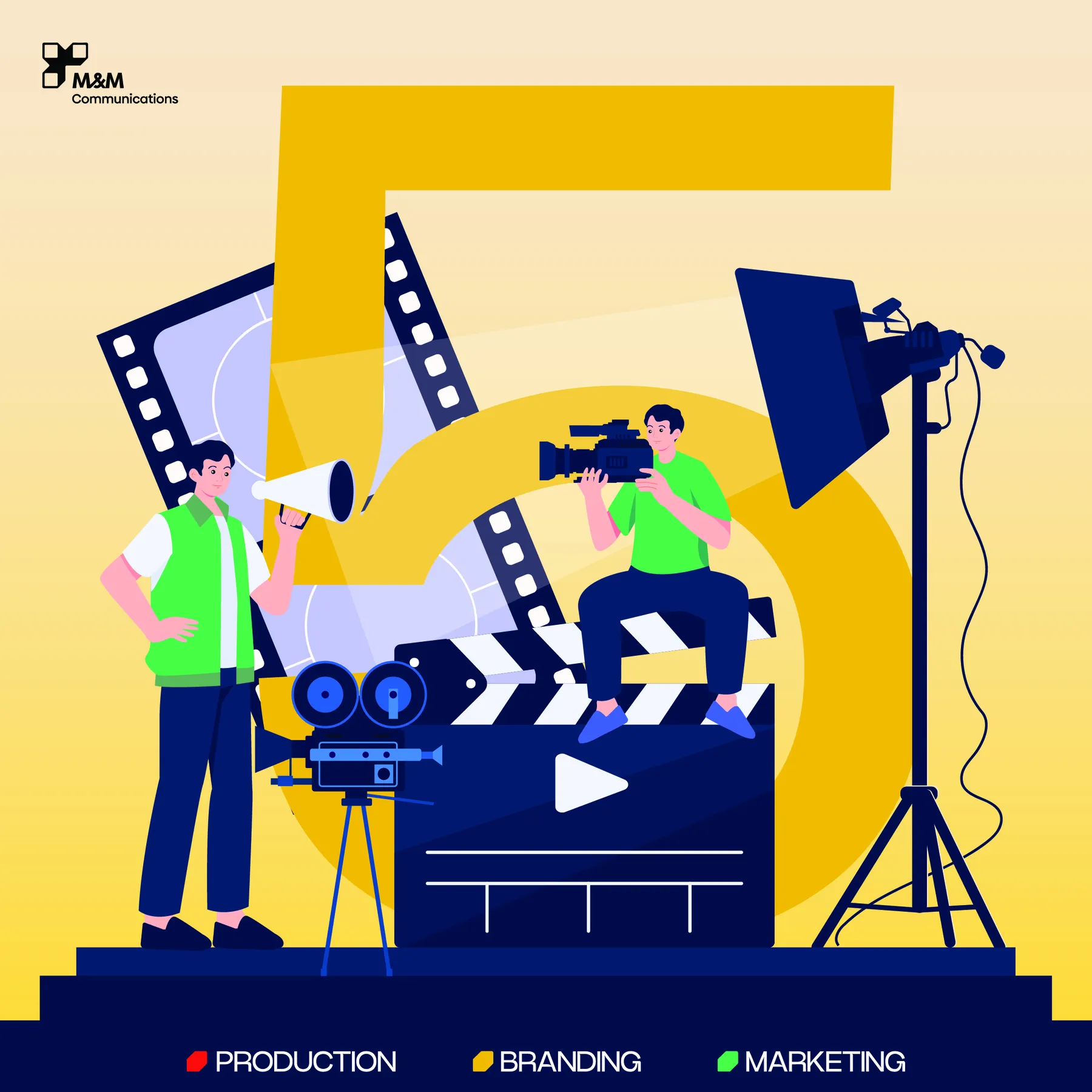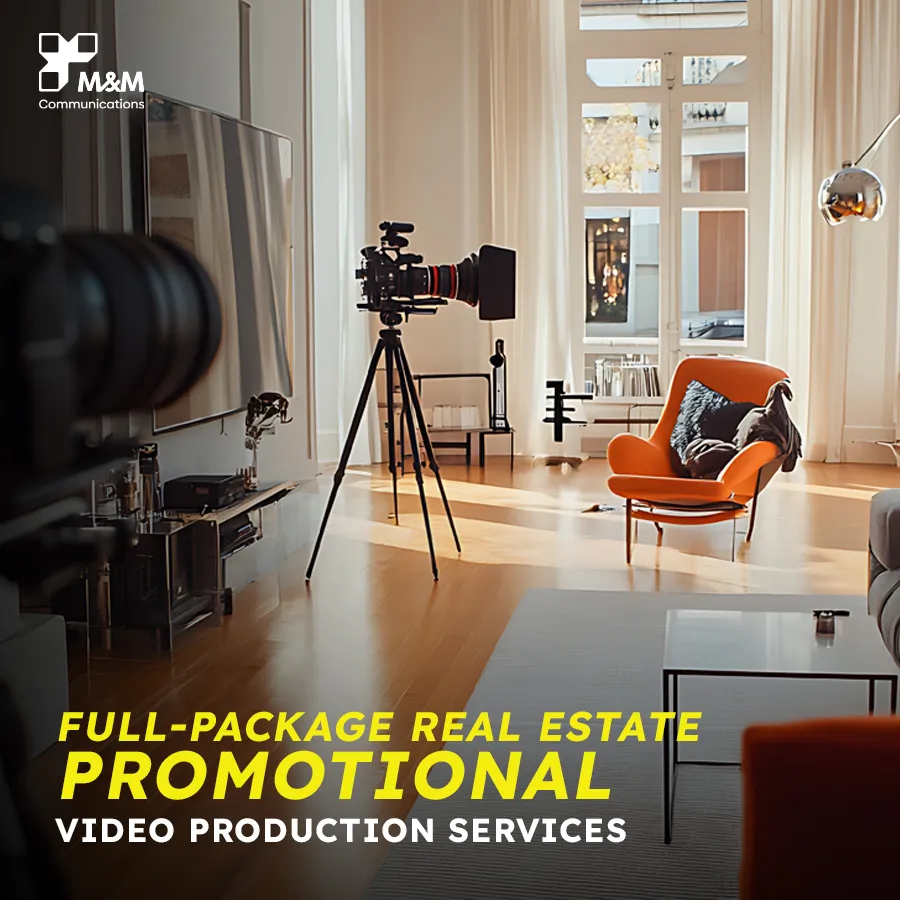
Drone Video Marketing 2025: Aerial Cinematography for Brands That Soar
The Sky's the Limit: Why Drone Video Marketing Dominates in 2025
There's something magical about seeing the world from above. Drone video marketing transforms ordinary scenes into extraordinary visual experiences, providing perspectives that ground-level cameras simply can't match. What was once the exclusive domain of Hollywood productions with helicopter budgets is now accessible to businesses of all sizes, thanks to revolutionary advances in drone technology.
At M&M Communications, we've incorporated drone cinematography into our production toolkit, delivering breathtaking aerial footage that elevates brand storytelling to new heights—literally. From sweeping establishing shots that set the scene to dynamic tracking shots that follow action with cinematic flair, drones have become essential for creating video content that stops scrolling thumbs and captures attention.
Drone Video Benefits: Unique Perspectives and Production Value
Unparalleled Visual Impact
Aerial footage immediately signals professional production quality. The human eye recognizes perspectives we don't experience in daily life, triggering heightened attention and emotional response. Drone shots convey scale, context, and grandeur in ways that ground-level footage cannot match.
Production value perception: Studies show viewers rate videos with aerial footage as 75% more professional and trustworthy compared to identical content shot only from ground level. This perception directly impacts brand credibility and purchase intent.
Cost-Effective Cinematic Quality
Traditional aerial cinematography required helicopter rentals costing $2,000-5,000+ per hour, limiting aerial shots to big-budget productions. Drone technology delivers comparable (often superior) footage at 5-10% of traditional costs, democratizing access to premium visual storytelling.
Versatility and Creative Freedom
Modern drones maneuver in spaces helicopters can't reach—flying between buildings, under bridges, through forests, or hovering inches from subjects. This versatility opens creative possibilities previously impossible or prohibitively expensive.
Rapid Deployment and Iteration
Unlike helicopter shoots requiring extensive planning, permits, and weather windows, drone operations deploy quickly and cost-effectively enough to allow multiple takes and experimental angles without budget catastrophe.
Drone Equipment Guide: Choosing the Right Tool
Consumer Drones (Under $1,000)
DJI Mini 3 Pro: Ultra-portable (under 250g) yet captures stunning 4K video with exceptional stabilization. Perfect for travel content creators, real estate agents, and small businesses wanting aerial capability without licensing complexity (sub-250g drones have simplified regulations in many jurisdictions).
Key specs: 48MP photos, 4K/60fps video, 34-minute flight time, obstacle avoidance, HDR video, vertical shooting mode for social media.
Best for: Social media content, real estate listings, small event coverage, travel vlogs, establishing shots.
Prosumer Drones ($1,000-$3,000)
DJI Air 3: Dual-camera system (wide and 3x telephoto) provides creative flexibility without changing positions. Advanced tracking modes follow subjects intelligently, enabling one-person operation for dynamic shots.
Key specs: Dual cameras, 46-minute flight time, omnidirectional obstacle sensing, 10-bit D-Log color, 12km transmission range.
Best for: Professional real estate, tourism promotion, event coverage, construction documentation, outdoor recreation brands.
Autel Evo Lite+: Strong alternative to DJI with 1-inch sensor delivering exceptional low-light performance. Variable aperture (f/2.8-f/11) provides creative depth-of-field control rare in consumer drones.
Professional Cinema Drones ($3,000-$10,000)
DJI Mavic 3 Cine: Hasselblad camera with Apple ProRes codec provides cinema-grade footage suitable for commercial work and broadcast. Built-in 1TB SSD handles massive file sizes from professional codecs.
Key specs: Dual cameras (20MP Hasselblad + 28x hybrid zoom), ProRes 422 HQ recording, 46-minute flight time, omnidirectional obstacle sensing.
Best for: Commercial productions, broadcast content, high-end real estate, tourism campaigns, corporate videos requiring maximum quality.
DJI Inspire 3: Professional cinema drone with interchangeable lenses and full-frame sensor options. Two-operator system (pilot + camera operator) enables complex choreographed shots impossible with single-operator drones.
Key specs: Interchangeable Zenmuse X9 gimbal cameras, 8K CinemaDNG and Apple ProRes RAW, 28-minute flight time, 360-degree obstacle avoidance, centimeter-level positioning.
Best for: Film productions, high-budget commercials, complex tracking shots, professional broadcast work.
Flight Regulations and Permits: Staying Legal
Understanding Airspace Classification
Drone operations must comply with civil aviation authority regulations. Key universal principles include:
Altitude restrictions: Most jurisdictions limit recreational/commercial drones to 400 feet (120 meters) above ground level to avoid conflicts with manned aircraft.
Line of sight: Operators must maintain visual contact with drones throughout flight (unless holding specific beyond-visual-line-of-sight waivers).
No-fly zones: Airports, military installations, government buildings, and temporary restrictions around VIP movements, emergencies, or events require checking NOTAM (Notice to Airmen) systems before flights.
Privacy considerations: Respect private property and individual privacy. Just because you can fly somewhere legally doesn't mean you should film without permission.
Commercial Operator Licensing
Most countries require commercial drone pilots to obtain certification demonstrating:
- Aeronautical knowledge (airspace, weather, regulations)
- Safe operating procedures
- Emergency protocols
- Maintenance requirements
United States: Part 107 Remote Pilot Certificate requires passing aeronautical knowledge test and TSA vetting. Renewal every 24 months via recurrent training.
European Union: EASA regulations require operator registration and pilot competency certificates based on drone category and operational risk.
Australia: ReOC (Remotely Piloted Aircraft Operator's Certificate) from CASA for commercial operations.
Insurance and Liability
Professional drone operations require insurance covering:
Public liability: $1-10 million coverage protecting against property damage or personal injury caused by drone operations.
Equipment coverage: Protecting your investment against crashes, theft, or technical failures.
Production insurance: If working on commercial productions, clients often require proof of insurance as contractual condition.
Aerial Photography Techniques: Mastering the Craft
The Orbit Shot
Circular movement around a subject while maintaining constant distance and altitude. This technique showcases subjects in 360-degree context, revealing relationships with surrounding environment.
Best applications: Architecture, landmarks, outdoor venues, real estate properties, event locations.
Execution tips: Use intelligent flight modes (Point of Interest/POI) for smooth orbits. Manual control requires practice coordinating yaw and lateral movement. Slower orbits appear more cinematic than fast circles.
The Reveal Shot
Starting with an obscured or limited view, then moving to reveal the full subject or unexpected context. This technique creates dramatic moments and emotional impact.
Variations:
- Rise and reveal: Start low behind obstruction, rise to show full scene
- Lateral reveal: Slide sideways from behind foreground element
- Pullback reveal: Start tight on subject detail, pull back to show larger context
Best applications: Tourism videos, real estate showcases, event coverage, destination marketing.
The Tracking Shot
Following moving subjects while maintaining consistent framing. Modern drones with ActiveTrack or similar AI-powered subject tracking make these shots accessible to single operators.
Types:
- Following: Drone behind subject moving in same direction
- Leading: Drone in front of subject, often flying backwards
- Parallel: Drone maintaining position alongside moving subject
- Overhead tracking: Bird's-eye view following subject below
Best applications: Sports, vehicles, outdoor recreation, event coverage, brand storytelling with human subjects.
The Top-Down Shot
Directly overhead perspective creates abstract patterns and reveals spatial relationships invisible from eye level. Particularly effective for subjects with interesting overhead geometry.
Best applications: Architecture, landscaping, crowds, geometric patterns, agricultural fields, event layouts.
Creative tip: Top-down shots work beautifully in time-lapse, showing movement patterns of people, vehicles, or environmental changes.
The Crane Shot
Vertical movement mimicking traditional camera crane operation. Rising shots build anticipation and grandeur; descending shots create intimate focus.
Applications: Opening or closing sequences, transitioning between scenes, revealing scale, building emotional crescendo.
Safety Protocols and Best Practices
Pre-Flight Checklist
- Weather check: Wind speed, precipitation, temperature, visibility
- Airspace verification: Check NOTAMs, temporary flight restrictions
- Battery status: Fully charged batteries, plan for return-to-home reserve
- Equipment inspection: Propeller condition, motor function, gimbal operation
- Site survey: Identify obstacles, emergency landing zones, RF interference sources
- Emergency procedures: Review return-to-home function, manual override procedures
Operating Guidelines
Wind limits: Most consumer drones struggle in winds exceeding 20-25 mph. Professional drones handle stronger winds but footage quality suffers. Plan flights during calm periods.
Battery management: Never deplete batteries below 20-30%. Always maintain reserve for unexpected situations requiring extended flight or fighting headwinds during return.
Backup equipment: Professional shoots require backup drones, extra batteries, spare propellers, and contingency plans for technical failures.
Communication: On commercial shoots, establish clear communication between pilot, camera operator (if separate), director, and ground crew.
Marketing Applications: Industries Transformed by Drone Video
Real Estate and Property Development
Drone footage revolutionized real estate marketing by showcasing properties in full context—neighborhood amenities, proximity to attractions, surrounding landscape beauty that ground-level photos miss entirely.
ROI impact: Listings with aerial footage sell 68% faster and achieve 3-5% higher sale prices on average. Investment of $200-500 in drone footage returns thousands in faster sales and premium pricing.
Beyond residential: Commercial real estate, land sales, development projects, and vacation rentals all benefit tremendously from aerial perspective.
Tourism and Destination Marketing
Nothing inspires wanderlust like sweeping aerial views of stunning destinations. Tourism boards worldwide leverage drone footage to showcase landscapes, attractions, and experiences in ways that trigger immediate booking intent.
Engagement metrics: Tourism content with aerial footage achieves 300% higher share rates and 150% longer average view duration compared to ground-level only content.
Events and Festivals
Capture the scale, energy, and atmosphere of events from perspectives attendees never experience. Aerial footage shows crowd size, venue layout, and overall spectacle in ways that ground-level coverage cannot match.
Applications: Music festivals, sporting events, corporate gatherings, weddings, cultural celebrations, trade shows.
Construction and Development Documentation
Regular aerial surveys document construction progress, identify issues before they become expensive problems, and create compelling time-lapse narratives of projects transforming from concept to completion.
Business value: Beyond marketing, aerial documentation aids project management, stakeholder communication, and legal protection in case of disputes.
Outdoor Recreation and Adventure Brands
Showcase activities in their natural environments—skiing mountains, surfing coastlines, hiking trails, mountain biking through forests. Aerial footage captures the adventure and beauty that draws enthusiasts to these activities.
Post-Production Workflow
Color Grading Aerial Footage
Aerial footage often requires different color grading approaches than ground-level content:
Atmospheric haze compensation: Distance and altitude introduce blue haze. Add warmth and clarity in post-production.
Sky management: Prevent blown-out skies by shooting in D-Log or similar flat profiles, then recover highlights in post.
Consistency matching: When cutting between aerial and ground footage, ensure color consistency for seamless transitions.
Stabilization and Speed Ramping
Despite excellent in-camera stabilization, subtle post-stabilization enhances smoothness. Speed ramping (varying playback speed) adds dynamic energy to aerial sequences.
Sound Design
Drone footage lacks usable audio (propeller noise dominates). Replace with:
- Ambient environmental sounds matching the scene
- Music that complements the emotional tone
- Sound effects that enhance realism (wind, waves, etc.)
Cost Structure: Investment and Pricing
Equipment Investment
Starter package ($800-1,200): Consumer drone, extra batteries, carrying case, ND filters, basic insurance.
Professional package ($4,000-8,000): Prosumer or entry cinema drone, multiple battery sets, professional ND filter system, landing pad, tablet/phone for monitoring, comprehensive insurance, licensing fees.
Cinema package ($15,000-40,000+): Professional cinema drone, interchangeable cameras/lenses, dual-operator system, backup drone, extensive accessories, commercial insurance, vehicle mounting systems.
Service Pricing
Basic aerial shoot (2-4 hours): $500-1,500 for consumer drone footage suitable for social media, basic real estate, small events.
Professional shoot (half day): $1,500-3,500 for broadcast-quality footage with professional pilot, equipment, and editing.
Cinema production (full day+): $5,000-15,000+ for complex shoots with multiple drones, operators, and cinematic deliverables.
Future of Drone Technology in Marketing
AI-Powered Autonomous Flight
Advanced computer vision enables drones to navigate complex environments autonomously, executing sophisticated shot sequences without pilot intervention beyond high-level creative direction.
Extended Flight Times
Battery technology improvements and hybrid power systems are extending flight times from current 20-45 minutes toward 60+ minutes, reducing battery-swap interruptions.
FPV Hybrid Systems
Combining stable cinema drones with FPV (First Person View) racing drone agility enables previously impossible shots—diving through windows, racing through tight spaces, creating high-energy sequences safely.
Swarm Technology
Coordinated drone swarms create light shows, capture multi-angle footage simultaneously, and enable creative applications impossible with single drones.
Getting Started: Your Drone Marketing Action Plan
Month 1: Foundation
- Research regulations in your jurisdiction
- Obtain necessary licenses/certifications
- Purchase appropriate equipment for your needs
- Secure insurance coverage
- Practice flying in safe, legal areas
Month 2: Skill Development
- Master basic flight maneuvers
- Practice cinematic shot types
- Learn editing workflow for aerial footage
- Study successful drone marketing examples
- Create test projects to build portfolio
Month 3: Business Integration
- Incorporate aerial footage into content calendar
- Identify clients/projects benefiting from drone perspective
- Establish pricing and service offerings
- Build portfolio showcasing capabilities
- Network with production community
Conclusion: Elevating Your Brand Above the Competition
Drone video marketing has evolved from novelty to necessity for brands wanting to create visually stunning content that captures attention in crowded digital spaces. The unique perspectives, production value, and emotional impact of aerial cinematography provide competitive advantages that ground-level footage simply cannot match.
At M&M Communications, we believe the best marketing tells stories that transport audiences emotionally. Drone footage literally transports viewers to new perspectives, creating experiences that resonate deeply and drive meaningful engagement with your brand.
The sky is no longer the limit—it's the opportunity. Whether you're showcasing real estate, promoting tourism, documenting events, or building brand prestige, drone video marketing elevates your storytelling to heights that command attention and inspire action.
Ready to take your video marketing to new heights? Contact M&M Communications today. Call 0909 123 456 or email hello@mmcom.vn to discuss how aerial cinematography can transform your brand's visual storytelling and create unforgettable impressions that convert viewers into customers.






